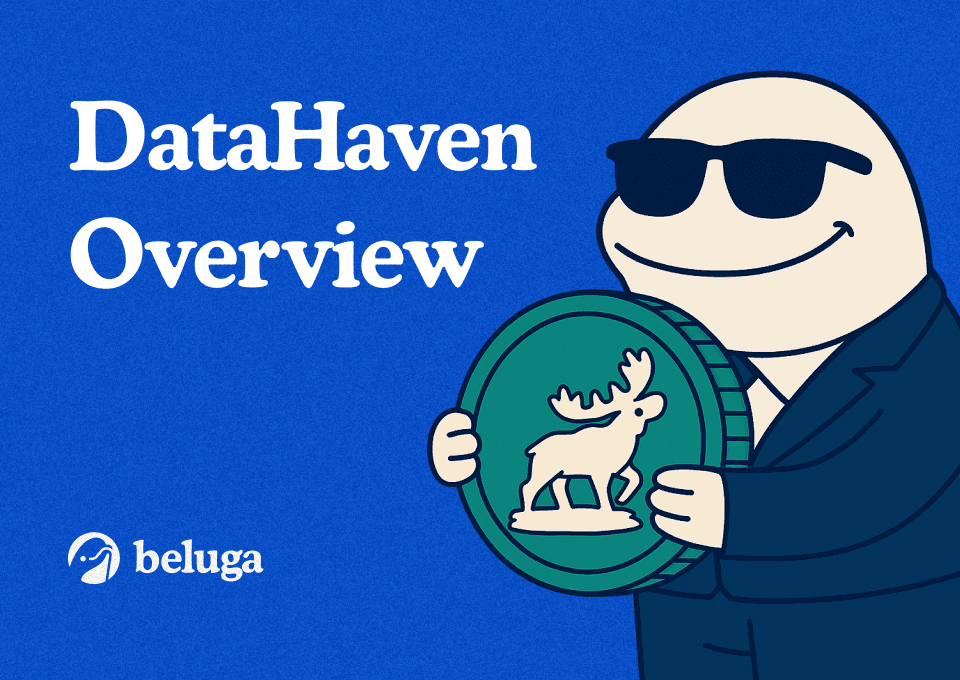An Overview of DataHaven: The Next Evolution of Onchain Data Storage
By Will McKinnon Updated June 4, 2025

Summary
- DataHaven announced its launch in January 2025, marking the project's public debut.
- This expansion of Moonbeam’s offering, financed by the Moonbeam Foundation by way of DataHaven, is a show of their dedication to the GLMR community and ecosystem.
- This dual-layer architecture means DataHaven is well-suited to handle storage for three major verticals: AI, Decentralized Physical Infrastructure Networks (DePIN), and Real World Assets (RWA’s).
Introduction
DataHaven is a new decentralized storage protocol built for verifiable AI and Web3 data. Making headlines with their launch announcement in partnership with EigenLayer in January, DataHaven aims to solve the critical infrastructure problem of secure, censorship-resistant storage for the rapidly expanding AI economy. Setting itself apart from general storage solutions, DataHaven is purpose-built for AI models, datasets and agent configurations, aiming to disrupt what it sees as a potentially $2.6 trillion dollar industry. In this article, we’ll dive into how DataHaven works, the team behind it, and their vision for the future of AI.
How Does DataHaven Work?
Leveraging their partnership, DataHaven operates as an Autonomous Verifiable Service (AVS) on EigenLayer, meaning it inherits Ethereum’s security through restaking. The protocol separates storage operations from blockchain consensus into a dual-layer architecture, allowing it to handle large datasets while maintaining cryptographic verification.

This dual-layer architecture means DataHaven is well-suited to handle storage for three major verticals: AI, Decentralized Physical Infrastructure Networks (DePIN), and Real World Assets (RWA’s).
AI: In the context of AI, DataHaven can store machine learning models, training sets, and agent configurations with built-in verification. For example, an AI company could upload a Large Language Model (LLM) to DataHaven and provide cryptographic proofs that the model hadn’t been tampered with or censored in any way.
It doesn’t stop there though, as the DataHaven chain itself is composable meaning apps and complex operations can be built on top of it. This opens the door for apps to build data marketplaces directly on DataHaven, which is a rapidly growing market with the rise of data-hungry AI agents.
RWA’s: For a world moving towards tokenized assets, secure and verifiable data storage is imperative. For example, a real estate tokenization platform could store property deeds, audits and any other relevant information on DataHaven, allowing users to access these records at any time and verify their validity.
An additional advantage for DataHaven is its native integration with Ethereum’s ecosystem. DataHaven is directly connected to Ethereum through a native, trustless bridge making interacting with Ethereum seamless and eliminates trust-assumptions typically associated with bridging.
Speaking of trust assumptions, DataHaven utilizes a Proof of Stake mechanism for storage providers which requires them to lock collateral in order to receive user data. If the provider loses any data or acts nefariously in any way, the collateral can be slashed, ensuring reliability of the providers on the network.
DePIN: DePIN involves the usage of a mass network of devices, all of which need to store data in a secure and verifiable manner. DataHaven’s network could be used to store things like air sensor readings, allowing users and developers to verify the authenticity of the data involved in the weather prediction models the sensors are used for.
The Team Behind DataHaven
DataHaven is led by experienced blockchain infrastructure builders with a track record of successful project execution.
Aaron Evans - Head of Operations
- 20+ years of hands-on, results-driven technical leadership experience with expertise in crypto, startups, and team management
- Built a $100M+ SaaS business as part of a four-person startup team, led global R&D teams of 150+ people
- Deep knowledge of cloud infrastructure and architecture, specializing in designing, building, and scaling applications and services
- Part of Moonbeam launch team
Sicco Naets - Head of Ecosystem
- Decades of experience in software development and engineering management, spanning blockchain technologies, cloud/data center infrastructure, and full-stack development
- Served as VP of Engineering at Fuze and held senior technical roles at Alcatel-Lucent
- Proven ability to build high-performing teams and ship complex systems under tight deadlines
- Part of Moonbeam launch team
Alex DiNuzio - Head of Growth and Strategy
- Proven track record of scaling operations and driving growth across multiple ventures, from boardroom strategy to daily execution
- Raised $4m+ for Jambb and orchestrated successful exit; Employee #1 at AssetBlock, a blockchain-based real estate investment platform
- Helped Fuze scale from 17-700+ employees while leading product development
Ryan Levy - Global Head of Business Development
- 25+ years in data infrastructure, including data centers, data and storage platforms, cybersecurity, and data analytics
- Joined specifically to lead DataHaven's business development, partnerships, and go-to-market strategy
- Deep expertise in blockchain, enterprise data systems, and storage solutions
Investment and Financial Backing
The DataHaven team has a strong track record of raising capital from a diverse set of institutions. Their previous venture, Moonbeam, secured $6 million in a strategic funding round led by Binance Labs, with participation from CoinFund and ParaFi Capital. The round also included prominent blockchain investors: Hypersphere Ventures, Hashkey Capital, Arrington XRP, KR1, D1 Ventures, Mechanism Capital, Divergence Ventures, and Signum Capital.
This expansion of Moonbeam’s offering, financed by the Moonbeam Foundation by way of DataHaven, is a show of their dedication to the GLMR community and ecosystem. Rather than a siloed, brand new project, DataHaven should be viewed as an extension of Moonbeam.
Strategic Partnership with EigenLayer
DataHaven's partnership with EigenLayer represents more than just a superficial integration. In addition to the technological advantages EigenLayer offers, it also allows DataHaven to strategically align itself with the largest programmable network, Ethereum. EigenLayer has emerged as one of the most significant innovations in Ethereum scaling, allowing validators to restake their ETH to secure additional services beyond the base blockchain, in turn earning those stakers higher yield.
As a "preferred partner" within EigenLayer's AVS ecosystem, DataHaven benefits from several advantages. The partnership provides access to Ethereum's $100+ billion in staked ETH for security, meaning storage clients of DataHaven’s also have their data secured by Ethereum. Protocols are naturally drawn to Ethereum and its Layer 2’s due to the security they provide to the underlying protocol. In the context of data storage, however, most of the options are secured by their own token rather than ETH. In other words, a protocol worth billions of dollars may have its data secured by a token worth only a fraction of that amount. DataHaven sets itself apart by allowing developers to rely solely on ETH for their trust assumptions.
The integration also simplifies the developer experience. Rather than bridging assets between separate blockchains, developers can interact with DataHaven storage directly from Ethereum smart contracts. An NFT marketplace could store image files on DataHaven and reference them in Ethereum contracts without additional bridge operations or trust assumptions.
Luke Hajdukiewicz, Head of AVS Business Development at Eigen Labs, stated:
We're excited to welcome DataHaven as a preferred storage partner to the EigenLayer AVS ecosystem. DataHaven is set to deliver a decentralized storage service, designed to secure your most valuable digital asset - data.
The partnership positions DataHaven within EigenLayer's growing ecosystem of AVS services, which includes oracle networks, bridges, and other middleware. As EigenLayer gains adoption, DataHaven benefits from increased visibility and integration opportunities with other AVS projects.
This contrasts with standalone storage networks that must compete for attention in a fragmented landscape. By aligning with EigenLayer's growth, DataHaven can focus on technical execution rather than building awareness from scratch.
Recent Developments and Outlook
DataHaven announced its launch and EigenLayer partnership in January 2025, marking the project's public debut. The team has released a technical litepaper outlining the protocol's architecture and plans to publish more detailed documentation in the coming weeks.
DataHaven’s Stagenet is now live as of May 20th meaning the code is officially running, a major milestone on the way to mainnet. To go along with the launch, they’ve also opened up applications for companies and projects looking to become a partner and build on DataHaven.
Current development focuses on several key areas, including building out the storage provider network and onboarding operators who will provide actual storage services. They're also developing integration tools and SDKs to make it easier for developers to incorporate DataHaven storage into existing applications.
Near-term milestones include launching the first production integrations with AI and Web3 applications, and of course the first public testnet coming soon.
Final Thoughts
DataHaven is a particularly exciting project as it occupies the intersection of some of the most important narratives within crypto: AI, Data Storage, RWA’s and DePIN. The team’s previous success with Moonbeam lends further credibility to the potential of DataHaven, and their partnership with EigenLayer allows them to access the Ethereum community in a way Moonbeam wasn’t able to. As the demand for AI grows, so too will AI’s demand for data storage - potentially growing the market to trillions of dollars over the next few years. It’s by no means an easy industry to break into, but with legacy storage providers like AWS still behind on the move to blockchain, there’s a massive window of opportunity for Web3-native players to step in.
Liked this article? Follow DataHaven on X and join their Discord to learn more!
Disclaimer: Beluga has a marketing partnership with DataHaven.
Join the Beluga Brief
Dive deep into weekly insights, analysis, and strategies tailored to you, empowering you to navigate the volatile crypto markets with confidence.
Never be the last to know
and follow us on X








